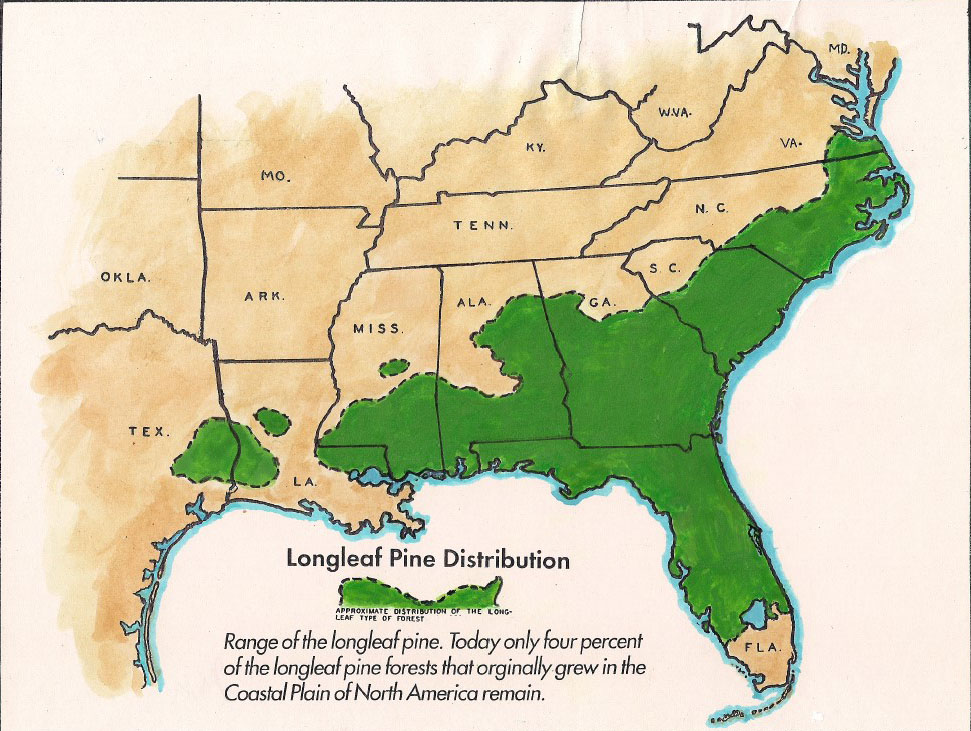A Brief History of the Longleaf Pine
During the 1700 and 1800s, longleaf populations began to fall as millions of acres were cleared to build communities and transportation routes. In addition, “fuels” of leftover logging debris on the forest floor caused catastrophic wildfires. Animal populations plummeted, with a cascading negative effect on the entire ecosystem. In the 1900s, people began to realize deforested areas were not reseeding in longleaf. Instead, faster growing species such as loblolly, slash and hardwoods were taking over. By the late twentieth century, preserved recreational areas protected the last reserves of high-quality longleaf habitat.
Bringing Back the Longleaf Population
The longleaf ecosystem has become an object of intense concentration by federal, state, non-profit and private entities. Strong efforts are underway to reforest with longleaf and manage existing stands. However, well over half of today’s longleaf pines exist on private land. This is why GFC is working alongside the Natural Resources Conservation Service (NRCS) and other agencies to reach out and involve landowners in protecting and reestablishing the longleaf pine.

Why Care About Longleaf Pine?
Protecting the longleaf pine isn’t just about protecting trees. Many threatened and endangered species, such as the Gopher Tortoise, Indigo snake, Hairy Rattleweed, Gopher Frog, Red Cockaded Woodpecker and many others, call longleaf forests home. Their survival depends on thinned and frequently burned open pine savannah.
Resources, Services and Programs for Longleaf Conservation
Federal and private funds available for restoring the longleaf ecosystem can make such efforts attractive to landowners. There are many ways landowners can receive help; capitalizing on these resources is a matter of knowing what is available and whom to contact. Below are some programs and services that can begin the process. GFC provides many longleaf ecosystem services and programs to landowners, often at no charge or at highly competitive rates.
Cost Share Programs
EQIP - Environmental Quality Incentives Program
Working Lands for Wildlife
Conservation Reserve Program
Partners for Fish and Wildlife
Local Grant Projects
Agencies are often looking for high priority areas in which to establish and manage the longleaf ecosystem. These agencies often have projects or grants, either active or in progress. Terms and assistance vary from project to project. The organizations below provide a good starting point for considering grants.
- Resource Conservation and Development Council
- Soil and Water Conservation Commission
- Longleaf Implementation Teams
Easements
An easement may not be appropriate for everyone, however, for the right landowner in the right location it can be an excellent way to protect land from future development, gain financially, and restore/manage the landscape. Easements that may work for landowner’s interested in longleaf pine conservation include:
- Working Forest Conservation Easements
- Agricultural Conservation Easement Program
- Georgia Land Trust
- The Nature Conservancy
Helpful Resources for Planting and Harvesting Longleaf Pine
Longleaf Pine is one of the more difficult southern yellow pine species to establish. While the rewards of longleaf can be great, it takes care and consideration during its initial establishment to ensure a healthy and productive stand of trees. Keep in mind that forestry technical guidance is subjective. Different resources favor different approaches. GFC recommends reviewing a wide range of resources before you decide which approach is right for you. To help you get started, we’ve compiled several articles and links that might help.
| Title | Description | Document Type |
|---|---|---|
| 2022 Longleaf Pine Accomplishment Report | ||
| A Closer Look at Stem Quality of Old-Field Planted Longleaf Pines | GFC worked with the University of Georgia on a longleaf pine stem quality study funded by a grant from the US Forest Service. This study was performed with the primary objective of quantifying the sawtimber and pole potential of longleaf pine trees planted in old-fields/pastures/hay fields. More than 200 landowner sites were | |
| America’s Longleaf Restoration Initiative (ALRI) | ALRI is a collaborative effort of multiple public and private sector partners that actively supports range-wide efforts to restore and conserve longleaf pine ecosystems. | External Website |
| Keys to Successfully Establishing a Longleaf Pine | Best practices for planting and maintaining longleaf pines | |
| Longleaf Pine Conservation Reserve Initiative | The Longleaf Pine Initiative restores and enhances longleaf pine ecosystems. The Conservation Reserve Program (CRP) provides farmers and landowners with initiatives like this to achieve many farming and conservation goals. | |
| Longleaf Pine Forest Establishment Hub | The Forest Stewardship Program is designed to integrate forest management objectives of sustaining quality native timber, native wildlife populations, soil & water resources, aesthetics, & recreation, over a 10-year planning period. This template provides landowners with technical guidance that places near-equal emphasis of these objectives. It prescribes conservation practices to establish new longleaf pine forests using either artificial planting methods or natural regeneration methods. | |
| Longleaf Range Map | ||
| Seedling Care And Planting Guidelines | Overview guidelines for successfully planting and caring for seedlings. | |
| Stem Quality Summary for Old‐field Planted, Unthinned Longleaf Stands in Georgia | Full Academic Longleaf Stem Quality Publication – This publication provides full data sets observed during the inventorying process, as well as some additional observations not covered in the landowner version. | |
| The Longleaf Alliance | The mission of the Longleaf Alliance is to ensure a sustainable future for the longleaf pine ecosystem through partnerships, landowner assistance and science-based education and outreach. | External Website |
